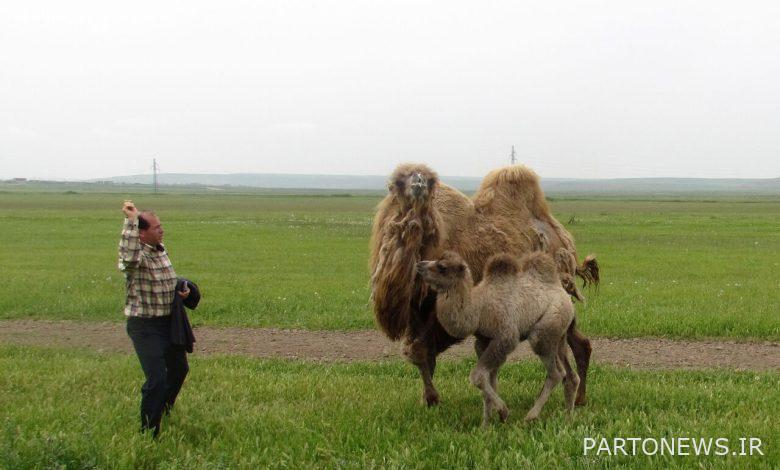The operational strategies of the bipedal camel conservation and rehabilitation project were reviewed

According to IRNA on Tuesday, in this specialized and consultative workshop attended by experts from the Food and Agriculture Organization of the United Nations (FAO), Advisor to the Deputy Minister and Executor of the National Camel Development Project and Director General of the Nutrition Improvement Office of the Ministry of Agriculture Jihad. And two-humped camel breeders were held in Moghan region, the executive and operational strategies for protection of two-humped camels were examined.
The revival of the ostrich must be done by the private sector
Executor of the country’s camel development project and director general of the nutrition improvement office of the Ministry of Jihad Agriculture in this specialized workshop, camels as drought-resistant animals and in accordance with Iran’s climatic conditions and called for the revival of this animal compatible with Iran’s climate with the participation of the private sector.
Seyyed Ahmad Reza Seyyed Alian called for directing all plans in the Ministry of Jihad Agriculture and all elements of the country to reduce reliance on water and said: “Unfortunately, we have not yet fully understood the danger of drought and use less plant and animal capacity compatible with this drought situation.” do.
Adviser to the Deputy Minister of Jihad for Agriculture on livestock affairs, called attention to the lack of water resources in the development of agricultural sector development plans and said: with the continuation of the current trend, the situation will worsen in the future Move resistant to drought and dehydration.
He said that focusing on the development of the agricultural sector towards the cultivation of drought-resistant plants and livestock is the only way out of the consequences of water scarcity in Iran and stressed: Be seriously supported.
The executor of the country’s camel development plan mentioned the intersection of two-humped and one-humped camels as one of the ways to breed productive and native cattle in Iran and said: “In this regard, we have started measures in Semnan province that will continue.”
He announced the transfer of management and leadership programs for the revitalization of bipedal camels to Ardabil province and added: “Revival of bipedal camels is a promotional and cultural program that has started with the participation of FAO in Ardabil province with $ 350,000.”
Seyyed Alian called for the transfer of the revitalization sector and the economicization of the process of keeping two-humped camels to the private sector and said: with a FAO plan or with five or 10 billion rials of credit, the endangered camel generation can not be revived. The hands of the people and the private sector.
He called for the development of an economic plan to maintain, revitalize and make profitable two-humped camel breeding in Ardabil province and said: “This camel has a great potential for revitalization with the advantage of meat production, and a revitalization plan should be developed in the form of meat and other products.” And be implemented.
Adviser to the Deputy Minister of Jihad for Agriculture on Livestock Affairs, referring to the existence of 9 camel ecotypes in Iran, added: will be.
He stressed: “The private sector and camel breeders are the main gene bank of bipedal camels and they should be guided to revive this species in the form of scientific programs, with the approach of economizing the breeding of bipedal camels.”

Revival and reproduction of bipedal camels; An opportunity for the agricultural sector of Ardabil province
The head of Ardabil Agricultural Jihad Organization in this specialized working group called for a wise look at the assets of the agricultural sector, especially in the plant and animal gene bank section in this province, and said: Located exclusively in Ardabil province.
Khalil Nikshad described the breeding of bipedal camels as an opportunity for the agricultural sector and in order to revive and preserve the local economy, nomadic culture and in accordance with the historical background of the province and Moghan region and said: In the south of Ardabil province there is a good breed of goat Its revival can boost the region’s agricultural economy.
He described the activity of 66,000 people in the livestock sector of Ardabil province as a huge economic and social capacity and added: “Today, the economy of 13,500 nomadic families in the province with 1.5 million head of light and heavy livestock needs a wise and expert view.”

The Moghan ostrich with a population of 215 is endangered
Deputy of Livestock Production Improvement of Ardabil Jihad Agricultural Organization in this ceremony, referring to the many capabilities in the livestock sector of Ardabil province, said: annually more than 400,000 tons of livestock products are produced in this province and half of it as a product in excess of need , Will be sent to other provinces.
Nubakht Ajdari mentioned the two-humped camel as one of the unique decaying domestic and indigenous animals in Ardabil province and added: the population of the two-humped camel in Ardabil province has increased from three thousand to less than 300 people in the current situation in the last 30 years.
He warned of the continuing declining trend in the population of Moghan bipedal camels: “If the current population of 215 Moghan ostriches falls below 100, it will mean the extinction of this rare species.”
Deputy of Livestock Production Improvement of Ardabil Jihad Agricultural Organization, referring to the establishment of two stations for breeding and reproduction of two-humped camels in Jihadabad Meshkinshahr and Jafarabad Moghan since 1374, said: The pure gene of this breed of camels, only in these two centers in the form of several live camels Stored.
He stated: out of this number of bipedal camels, only 92 are productive camels and these two stations, despite 42 productive male camels, are facing a shortage of productive male camels.
He called the danger of complete extinction of the Moghan bipedal camel serious and mentioned the closure of camel breeding by nomads, change in lifestyle, nomadic settlement and the diminishing role of camels in nomadic migration as reasons for the decrease in bipedal camel population in Ardabil province.
Lack of sufficient population for breeding, smuggling of live bipedal camels to neighboring countries, lack of economic justification for keeping herds for camel owners, lack of codified laws to protect rare camel species, lack of camel owners’ cooperatives, increased inbreeding, prolonged generation distance, conversion He mentioned the camels’ pastures and pastures on agricultural lands, the lack of a camel veterinarian and the lack of male camels as serious threats to the Moghan bipedal camel breed.

Special feature of Moghan bipedal camel
Moghan Iranian two-humped camel has a large body, a lot of wool and fur and is very resistant to heat and cold.
According to local nomads, this camel is very resistant to walking and has a high ability to move in mountainous and rocky areas.
This species of camel is heavy and compared to other species of camels and camels in other countries, mixing with this species gives birth to resistant camels with high weight gain.
The two-humped camel in Moghan was kept and raised by the nomads of the region in the past years and they were fed next to the sheep herds of the nomads, but today a small number of these camels are fed manually.
Although in the past, the nomads of Moghan region used two-humped camels to carry and transport their furniture, but they did not establish a special storage place for these camels and used and kept them as animals along with herds in the traffic between summer and winter. .
The breeding of this camel was very useful for the pastures in the past years because many plants that were weeds and harmful plants in the pastures, were bred by this species of camel and the growth and reproduction of some plant species, especially prickly and thorny species in the pastures were controlled. .
In addition, due to its large size, the Moghan bipedal camel has the ability to produce more meat, and due to its special anatomy in the ecotourism and tourism units, it also has the advantage of attracting tourists.

Initiation of resuscitation and protection measures for bipedal camels
Practical measures to protect and revive this rare species of camel in the Moghan region as the genetic repository of this rare species of Iranian camel in the Middle East began following a sharp decline in the population of bipedal camels.
Accordingly, in order to prevent the extinction of this camel breed, the Jihadabad Meshginshahr bipedal camel protection and breeding station was established by the Jihad Agricultural Research Center in 1974. Currently, several camels are kept and bred in this station. Sperm storage and embryo transfer are done in this center and in the shadow of the implementation of resuscitation programs, 21 camel camels are currently bred by the colleagues of this research center.
In addition to this center, in 1984, three bipedal camels were purchased with the financial support of the Breeding Center through the Deputy for Livestock Affairs and are kept in Jafarabad Moghan Livestock Research Station and next to Moghan Sheep Breeding Station. The camel breed is kept in this The center has now reached 32 people.
The Jafarabad Two-Mountain Camel Conservation and Development Center has been selected as the target for the review, planning and support of the Food and Agriculture Organization of the United Nations (FAO).
In addition, several camels have been transferred to Tolo Semnan station in recent years for research, interbreeding, sperm storage and reproduction.
According to IRNA, the two-humped camel is the only two-humped breed of Iranian camels, the last of which is exclusively bred in Ardabil province, but is endangered due to population decline.
This camel species in Ardabil province, a small number of which have been transferred to East Azarbaijan and Semnan provinces for study work, is kept and bred in the north of Ardabil province by the nomads of Moghan region and also in two centers of Jihad Agricultural Organization.
Moghan region in the north of Ardabil province, which has long been the breeding ground and habitat of bipedal camels in the country, is the last habitat and as a genetic repository of this rare animal species.
This rare species of camel was kept and used in the recent years among the nomads for migration and transportation of nomads’ furniture from summer to winter and vice versa, but in recent years, with the change of nomadic lifestyle and mechanization of nomads, its previous position from Lost.
With the continuation of this process, the population of the unique bipedal camel breed in Ardabil and East Azerbaijan provinces gradually decreased from about 70,000 in the 1950s and was on the verge of extinction, so that in the early 70s, the number This number of camels was reduced to about 70 people.
Currently, in Ardabil province, a total of 215 two-humped camels are kept by 18 breeders in two research stations of Jihad Keshavarzi.
Local ranchers and nomads have a total of 107 bipeds, most of whom keep one or two camels, and some nomads in the Moghan region have 14 bipeds.

